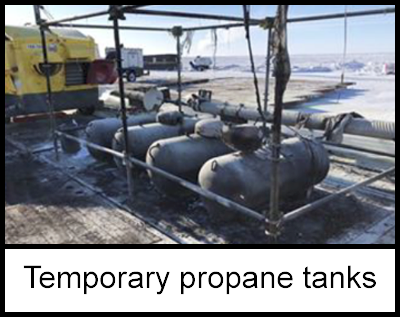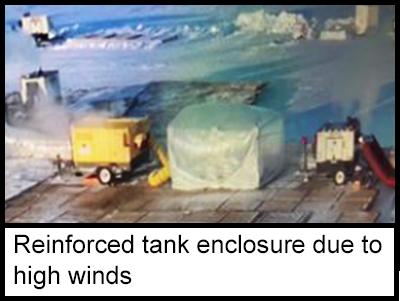-
What happened?
During flowback and flaring operations, a 120-gallon propane tank, began venting through the pressure relief valve.
The vapours left the temporary enclosure and were ignited by a nearby indirect fired heater being used to keep the propane warm.
Subsequent fire caused the remaining tanks to relieve.

-
Why did it happen?
The tank regulator or pressure release valve failed or activated prematurely, releasing gas into the enclosure.
The temporary enclosure was reinforced due to high winds.
The indirect fire heater was placed too close to the temporary enclosure.
The tanks were American Society of Mechanical Engineers certified, which have a lower relief setting than the Department of Transportation certified tanks.

-
What did they learn?
Do not use heated temporary enclosures to keep gas warm.
Review alternative fuel sources to replace propane.
Ensure there is adequate spacing in-between heaters and other items.

-
Ask yourself or your crew
What actions could have been taken?
Could we replace our current gas storage tanks with something better/safer?
How can we establish an adequate distance between gas storage tanks and heat sources?

Add to homescreen
Content name
Select existing category:
Content name
New collection
Edit collection
What happened?
During flowback and flaring operations, a 120-gallon propane tank, began venting through the pressure relief valve.
The vapours left the temporary enclosure and were ignited by a nearby indirect fired heater being used to keep the propane warm.
Subsequent fire caused the remaining tanks to relieve.

Why did it happen?
The tank regulator or pressure release valve failed or activated prematurely, releasing gas into the enclosure.
The temporary enclosure was reinforced due to high winds.
The indirect fire heater was placed too close to the temporary enclosure.
The tanks were American Society of Mechanical Engineers certified, which have a lower relief setting than the Department of Transportation certified tanks.

What did they learn?
Do not use heated temporary enclosures to keep gas warm.
Review alternative fuel sources to replace propane.
Ensure there is adequate spacing in-between heaters and other items.
Ask yourself or your crew
What actions could have been taken?
Could we replace our current gas storage tanks with something better/safer?
How can we establish an adequate distance between gas storage tanks and heat sources?
A 120-gallon propane tank began venting through the pressure relief valve. The vapours were ignited by a nearby indirect fired heater. Subsequent fire caused the remaining tanks to relieve.














